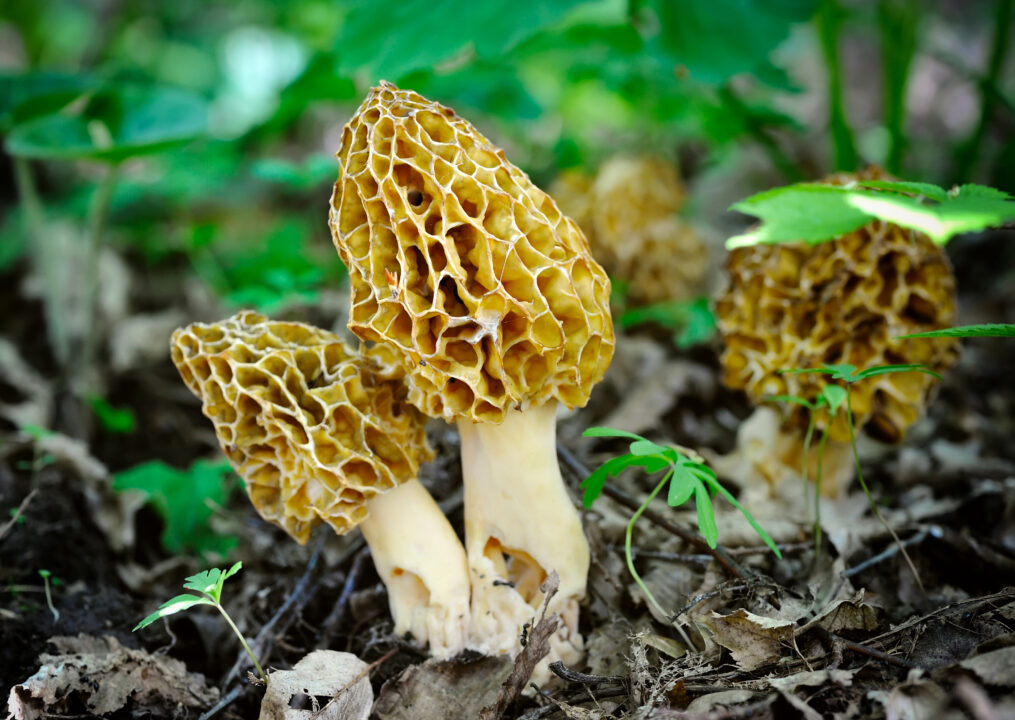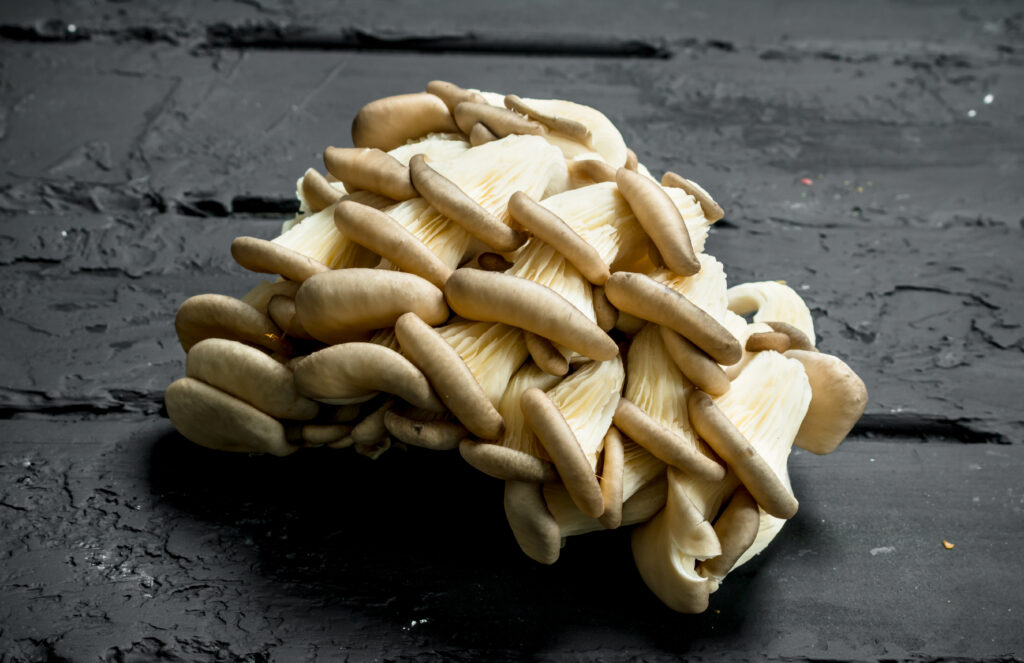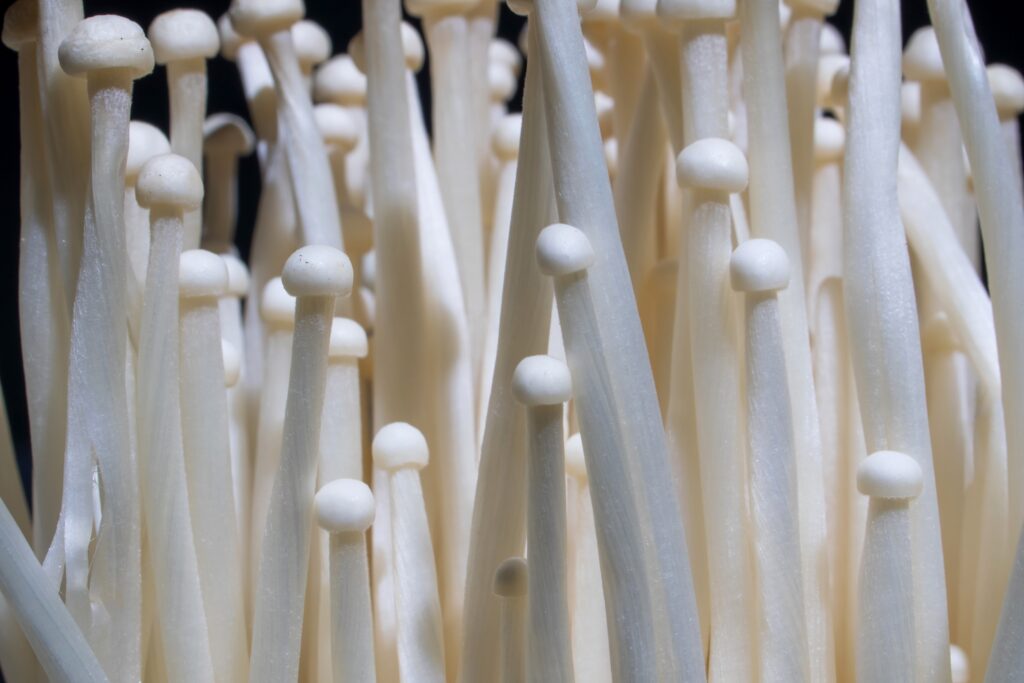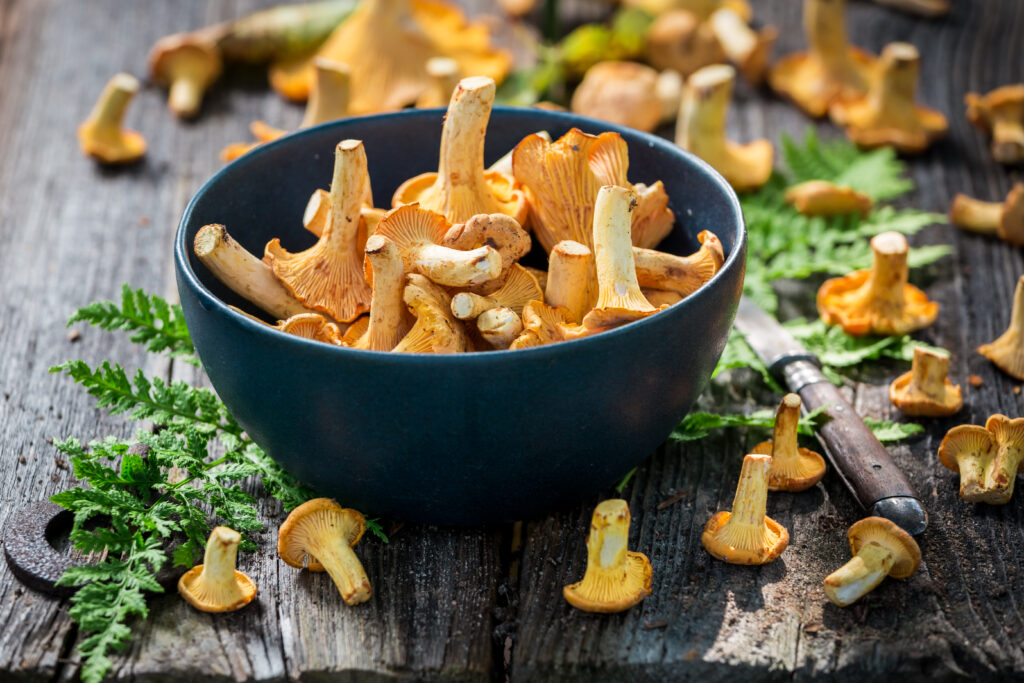Mushrooms are a type of fungi that come in various shapes, sizes and colors. They are unique organisms that reproduce through spores and thrive in diverse environments. They can be found in forests, grasslands and even on decaying logs. While some are edible and used in culinary dishes, others are poisonous and can be harmful if ingested.
Because of this, it is important to purchase your mushrooms from a reputable source and not wild-forage them without clear guidance.
Even edible mushrooms can contain carcinogenic compounds like hydrazine. It is essential to thoroughly cook mushrooms so the potential toxins can be neutralized.
10 Different Kinds Of Mushrooms
1. Morel Mushrooms

Morel mushrooms (Morchella) have a unique appearance with a honeycomb-like cap and hollow stem. They are highly sought after by chefs for their distinctive nutty and earthy flavor in dishes like pasta, risotto and sauces.
They are commonly sauteed or roasted to enhance their rich flavor profile. They will typically have a high price point and are considered a gourmet ingredient in the culinary world due to their eye-catching honeycomb appearance. When using morel mushrooms in your recipes, it’s important to cook them thoroughly to neutralize any potential toxins present in the raw mushroom.
2. Portobello Mushrooms
Portobello mushrooms (Agaricus bisporus), also known as portabella or portobello mushrooms, are a popular choice among chefs and are used throughout their growing stages.
Despite their different names, white button mushrooms, cremini mushrooms, cup mushrooms, flat mushrooms and Swiss brown mushrooms are all portobello mushrooms at different maturity levels.
These large, meaty mushrooms have a rich, earthy flavor and a firm texture, making them a versatile ingredient in various dishes. Portobello mushrooms are often used as a meat substitute in vegetarian and vegan recipes; they’re substantial in size and have a have a hearty taste.
3. King Oyster Mushrooms
King oyster mushrooms (Pleurotus eryngii), also known as king trumpet mushrooms, have thick white stems, small brown caps and a meaty texture.
With a mild, nutty flavor, they are a popular choice for adding depth and umami to a variety of dishes in commercial kitchens, absorbing flavors as they cook. They feature a visually appealing cross-section when cut, which enhances the overall culinary presentation of the meal.
They are often used in stir-fries and soups, as well as as a meat substitute in vegan and vegetarian dishes.
4. Oyster Mushrooms

These mushrooms come in various colors, including white, gray and pink, and feature a distinctive fan-like shape. With a mild, slightly nutty taste, oyster mushrooms can be sauteed, grilled, or stir-fried.
They also pair well with other ingredients, such as garlic, thyme, butter and white wine. Their ability to absorb flavors during cooking makes them a popular choice for marinating or seasoning with herbs and spices.
5. Enoki Mushrooms

These mushrooms have a slightly crunchy texture and a subtly sweet flavor. Stronger ingredients can easily overpower them.
Enoki mushrooms, a popular choice in Asian cuisine, are commonly used in soups, salads, stir-fries and hot pots. They add a unique visual appeal and delicate taste to an array of menu selections.
6. Chanterelle Mushrooms

These mushrooms have a distinctive golden color and a funnel shape with ridges on the underside instead of traditional gills.
Chanterelles are commonly used in upscale restaurants and culinary applications due to their unique taste and texture. They can be sauteed, roasted or used as a topping for pizzas and omelets for a gourmet touch. Chanterelle-infused sauces are also commonly used to complement poultry, pork or seafood dishes.
Pickled chanterelles make a tangy and flavorful addition to salads, charcuterie boards, or sandwiches.
7. Beech Mushrooms
Beech mushrooms are characterized by their small, slender stems and petite, button-like caps. They grow in clusters, with the caps tightly packed together.
These mushrooms are native to East Asia and are available in both white and brown varieties (with the white variety having a milder flavor compared to the more robust brown variety).
The flavor profile of beech mushrooms can be described as mild, nutty and slightly sweet. When cooked, these mushrooms develop a rich umami taste, which enhances the overall flavor of stir-fries, soups and noodle dishes.
8. Truffle Mushrooms
Truffles are spores from the Tuberaceae fungi. They have a rough, knobby exterior that ranges in color from black (Tuber melanosporum) to white (Tuber magnatum), resembling lumps of soil or rocks. Because they grow underground, they must be harvested with the help of trained dogs or pigs, making them a luxury ingredient to add to dishes.
Known for their strong musky aroma and rich, savory taste, truffle mushrooms are a favorite among chefs and food enthusiasts looking to elevate the flavor of their dishes. Due to their high cost and limited availability, they are considered a delicacy in the culinary world.
9. Black Trumpet Mushrooms
Black trumpet mushrooms (Craterellus cornucopioides), also known as horn of plenty or trumpet of death, feature dark black trumpet-shaped caps and are hollow and vase-like in shape. They have a rich and earthy flavor, which is often described as smoky or nutty.
They also have a delicate and tender texture, which adds a pleasant mouthfeel to any dish they are used in. Their flavor profile and texture make them a great addition to salads, soups, stews, risottos and pasta dishes.
They can also be sauteed or roasted and used as a topping for pizzas or incorporated into sauces and gravies.
10. Lobster Mushrooms
Lobster mushrooms (Hypomyces lactifluorum) are known for their vibrant red appearance and savory flavor profile. These mushrooms are not a distinct species but rather a parasitic fungus that grows on certain species of mushrooms, transforming them into a red lobster-like color. They have a firm texture and a taste reminiscent of seafood, making them a popular choice for adding depth to dishes such as soups, sauces and risotto.
With their eye-catching appearance and robust briny flavor, they are versatile for plant-based recipes like vegan lobster rolls, mushroom bisque and vegetarian ceviche.
Benefits of Mushrooms
Mushrooms are a low-calorie food and pack a nutritional punch. Loaded with many health-boosting vitamins, minerals and antioxidants, they’ve long been recognized as an important part of any diet.
Mushrooms exposed to ultraviolet light are a good source of vitamin D, an important component for bone and immune health.
Cremini mushrooms are an excellent source of zinc, which is an important nutrient for the immune system and is also needed for ensuring optimal growth in infants and children.
Researchers have found a number of other excellent reasons for adding mushrooms to your diet, such as:
-
Lower blood pressure
Mushrooms are a rich source of potassium, a nutrient known for reducing the negative impact that sodium can have on your body. Potassium also lessens the tension in blood vessels, potentially helping to lower blood pressure.
Additionally, they have a low level of sodium, so using them in recipes that call for saltier ingredients can reduce your sodium intake, which in turn helps with blood pressure.
-
Boost immune system
The anti-inflammatory effect of mushrooms has been shown to greatly improve the efficiency of the immune system. They contain high amounts of selenium, vitamin D and vitamin B6. They can help prevent cell damage in our bodies, vitamin D helps with cell growth and vitamin B6 helps our bodies form red blood cells. All of these nutrients in mushrooms help to maintain a healthy immune system.
-
Lose weight
Long- and short-term studies have found that mushrooms, in combination with exercise and other lifestyle changes, can have an important impact on weight loss.
It is thought that the antioxidants in mushrooms may increase cells’ defense systems, thus improving anti-inflammatory actions and protecting against obesity-related hypertension.
-
Mushroom Nutrition
Mushrooms are a rich, low-calorie source of fiber, protein, and antioxidants. They may also help to lessen the risk of developing serious health conditions, such as Alzheimer’s, heart disease, cancer and diabetes.
Mushrooms are also great sources of:
- Selenium
- Copper
- Thiamin
- Magnesium
- Phosphorous
Nutrients per serving
One cup of whole cremini mushrooms contains:
- Calories: 15
- Protein: 2.2 grams
- Fat: 0.1 grams
- Carbohydrates: 3.7 grams
- Fiber: 0.5 grams
- Sugar: 1.5 grams
Portion sizes
One cup of chopped mushrooms is considered the typical serving size. Thanks to their umami taste, mushrooms can be used as a substitute for meat in many dishes.
How to Prepare Mushrooms
Mushrooms are almost always readily available in the produce section of any grocery store or health food store. They are easy to grow at home as well. You can eat crimini mushrooms raw, cooked, sliced or unsliced. They can be simmered in a pot of water for about 5 minutes until soft, or sautéed in a hot skillet.
When sautéing, cook the mushrooms in a pan with olive oil on medium heat for about 8 minutes, stirring frequently, until they brown at the edges. Chopped mushrooms can be sprinkled raw over your meals to add a little more texture and flavor. Just make sure to wash them thoroughly first.
Conclusion
Some mushrooms are edible and have tastes ranging from sweet to nutty, and others even taste like lobster.
Other varieties can be used for their medicinal benefits, which boost your immune system, lower blood pressure and cholesterol, and may even be useful for treating cancer and other serious diseases.



